MacDonald’s Magic. In the L.A. Times obituary February 6, 1991 for one-man sound effects genius Jimmy MacDonald, it mentioned “MacDonald credited his engineering studies – through a correspondence course – for much of his success, citing in particular the time that he used clusters of duralumin to simulate the tones of the Western chromatic scale. This was to reflect the sound a spider makes when spinning a web. He once was asked if the spinning of a web could really make a sound. ‘When Walt Disney said it could, you made it have a sound,’ was the reply.”
D’Oh Homer. In 1991, The U.S. Council for Energy Awareness, a public interest group, complained to Fox’s The Simpsons about its portrayal of Homer Simpson and his fellow nuclear plant workers as “bumbling idiots”. Executive producer Sam Simon conceded that in real life, Homer “would not be employed at a nuclear-power plant. On the other hand, he probably wouldn’t be employed anywhere.”
 Enriching Animation. “As a kid, I always wanted to work at Disney. When I finally got there, I spent most of my time fighting about things instead of creating. I just want to put something on flilm that will enrich society,” said animator/director Don Bluth in PREVUE magazine (Feb/March 1981).
Enriching Animation. “As a kid, I always wanted to work at Disney. When I finally got there, I spent most of my time fighting about things instead of creating. I just want to put something on flilm that will enrich society,” said animator/director Don Bluth in PREVUE magazine (Feb/March 1981).
 Fuzzy Little Animals. Chuck Jones, interviewed in Business Screen magazine (Aug/Sept 1982) said, “We keep coming back to the idea that people want to do fuzzy little animals. Is Fantasia (1940) fuzzy little animals? Some people are always talking of fuzzy little animals as though they were all that we or Disney ever did. None of our characters was fuzzy. Indeed until Xerox came along you couldn’t even make a fuzzy animal.”
Fuzzy Little Animals. Chuck Jones, interviewed in Business Screen magazine (Aug/Sept 1982) said, “We keep coming back to the idea that people want to do fuzzy little animals. Is Fantasia (1940) fuzzy little animals? Some people are always talking of fuzzy little animals as though they were all that we or Disney ever did. None of our characters was fuzzy. Indeed until Xerox came along you couldn’t even make a fuzzy animal.”
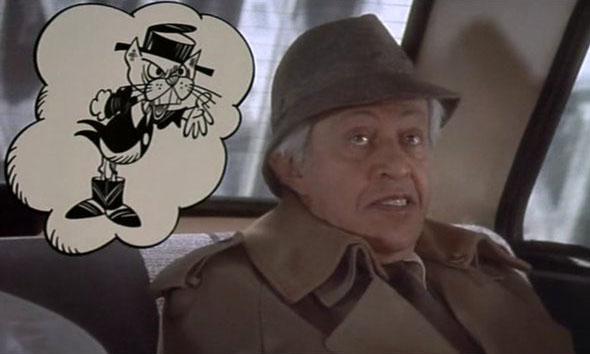
HeppCatt Animated. I Want To Go Home (1989) was a film by Alain Resnais about a veteran American cartoonist played by songwriter Adolph Green who visits France for an exhibition. The film was written by Jules Feiffer who created the “vintage” character of HeppCatt supposedly done by the cartoonist. Feiffer did up six daily strips and a Sunday page but they are shown only briefly in the film.
HeppCatt, however, does appear throughout the film in limited animation as the cartoonist’s conscience. As Feiffer told Graphic Story Monthly in its May 1990 issue: “Resnais wanted the cartoon characters in (the film) there some way. We intended much fuller animation but then Roger Rabbit came out and he realized that there was no way of competing with their time, money, and brilliance. It seems to me that is the ultimate. He was wary of anyone drawing any comparisons so he moved in a different direction. I had a wonderful time. I made four or five trips to Paris in the making of the film.”
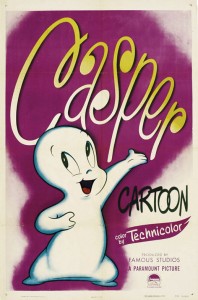 Who Created Casper? In The Peg-Board (May 1976), a publication of the Motion Picture Screen Cartoonists Union, animator Isadore (Izzie) Klein wrote “an imaginary conversation” between a grandfather and his grandson about how Casper was created: “Casper was thought up by some fellow whose name I don’t know. [Editor’s Note: That writer would be Sy Reit] He sold the first Casper script to a man named Joe for twenty-five dollars. [Editor’s Note: I’d assume the man he’s referring to is Joe Oriolo] Joe sold the original Casper script to Mr. Sam Buchwald, who was the manager of Famous Animated Cartoon Studio for Paramount Pictures.
Who Created Casper? In The Peg-Board (May 1976), a publication of the Motion Picture Screen Cartoonists Union, animator Isadore (Izzie) Klein wrote “an imaginary conversation” between a grandfather and his grandson about how Casper was created: “Casper was thought up by some fellow whose name I don’t know. [Editor’s Note: That writer would be Sy Reit] He sold the first Casper script to a man named Joe for twenty-five dollars. [Editor’s Note: I’d assume the man he’s referring to is Joe Oriolo] Joe sold the original Casper script to Mr. Sam Buchwald, who was the manager of Famous Animated Cartoon Studio for Paramount Pictures.
“Joe sold the script for one hundred dollars, making a clear profit. I was on the story staff at Famous. I was also animating for the studio. Sam called all of the story men into his office for a big story meeting. For hours, we were up against a stone wall. It looked like Casper was a one-shot idea. Then late in the afternoon, someone made a suggestion that cracked the stone wall. We all started to bounce around the new thought and plot number two for Casper sort of jelled up into an outline.”
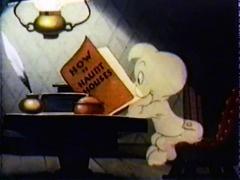
“Ghost Wanted” (1940)
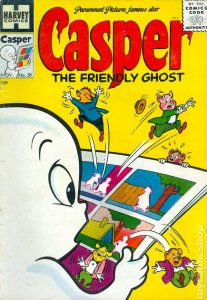 Of course, Klein responded in the August 1976 issue of Peg-Board: “Nowhere in my article did I claim credit. As I said, the original story was created outside Famous Studio. I did not know until now that you were one of those “ME, TOO!” guys – that you, could have done the thing but couldn’t dirty your hands for the money or some other excuse. That is all very noble or whatever – but all I was pointing up was that the Harvey outfit did NOT create Casper the Friendly Ghost. I would suggest you re-read ‘An Imaginary Conversation’.”
Of course, Klein responded in the August 1976 issue of Peg-Board: “Nowhere in my article did I claim credit. As I said, the original story was created outside Famous Studio. I did not know until now that you were one of those “ME, TOO!” guys – that you, could have done the thing but couldn’t dirty your hands for the money or some other excuse. That is all very noble or whatever – but all I was pointing up was that the Harvey outfit did NOT create Casper the Friendly Ghost. I would suggest you re-read ‘An Imaginary Conversation’.”
Animator Dave Tendlar also had a letter in that issue: “About Chuck Jones’ letter in the last issue of The Peg-Boad, commenting as how ghosts were around his studio years before Casper. Yes, there were a lot of mice around years before Disney thought up Mickey. And also a lot of cats and rabbits and dogs and birds and even Gertie, the Dinosaur. They were all here before us cartooners were around and they’ll be here long after we’re gone.
“Remember, Casper was a very successful long run cartoon series for theater and TV and not a one-shot idea, as at Schlesinger’s studio. No ‘lifts’ were involved here. So, Chuck, let’s give those Casper writers and animators the credit they deserve, instead of the cheap shot, aimed at our hard-working fellow cartoonists who still take pride in their creative endeavors of the past.”


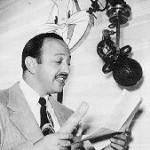
 Jim Korkis is an internationally respected animation historian who in recent years has devoted his attention to the many worlds of Disney. He was a columnist for a variety of animation magazines. With his former writing partner, John Cawley, he authored several animation related books including The Encyclopedia of Cartoon Superstars, How to Create Animation, Cartoon Confidential and Get Animated’s Animation Art Buyer’s Guide. He taught animation classes at the Disney Institute in Florida as well as instructing classes on acting and animation history for Disney Feature Animation: Florida.
Jim Korkis is an internationally respected animation historian who in recent years has devoted his attention to the many worlds of Disney. He was a columnist for a variety of animation magazines. With his former writing partner, John Cawley, he authored several animation related books including The Encyclopedia of Cartoon Superstars, How to Create Animation, Cartoon Confidential and Get Animated’s Animation Art Buyer’s Guide. He taught animation classes at the Disney Institute in Florida as well as instructing classes on acting and animation history for Disney Feature Animation: Florida.




















































The little ghost from Chuck Jones’ Ghost Wanted 1940) appeared five years before The Friendly Ghost came out in 1945, and Chuck Jones’s version was a prototype for how Casper was going to look like from a obese whiny crybaby of a ghost to the ghost that we all know of today.. And in Ghost Wanted the voice of the Big Ghost was no other but Fred “Tex” Avery.
Re: Casper – Chuck’s cute little boy ghost didn’t scare people — but he tried to, unlike Famous’ character. The peg of Jones’ cartoon was he ended up being terrified by the Tex Avery-voice adult ghost in the old house. Which in turn — and ironically, considering the more child-friendly Disneyesque stuff Chuck was doing for the most part in 1940 — made “Ghost Wanted” far more adult-friendly than what Casper turned out to be, where the repetitious story lines by the time it was pulled out of the Noveltoons into its own series was almost totally geared towards the kids in the theater audience.
I have always felt the outrage directed at Chuck Jones over this was misplaced. There is so much sheer brilliance in Jones’ work that I can’t see him needing or caring for credit for the creation of Caspar. As but one example in a field filled with diamonds, how many remotely came up with anything as inspired as ONE FROGGY EVENING?
Yeah, we shouldn’t forget that Chuck Jones was a god among men, worthy of our unquestioning adoration always and forever. He trod the path alone, sowing seeds of genius with every footfall! He invented a singing frog, and the output of the entire studio behind him, including Freleng, McKimson, Tashlin, and so many more pales in comparison!
I would like to think that Jones was being tongue-in-cheek knowing that many cartoons share basic ideas but told differently…but i think he did use that retroactive plagiarism line in comparing Disney’s The Aristocats to Gay Purr-ee.
As a kid I thought that that Aristocats was a “sort of sequel ” of Gay Purr-ee and since Gay Purr-ee was set in Turn of the Century France (1895) where Mewsette a country cat with Big City Dreams chastise Juane Tom for catching mice as she called them “Those Horrid Things” and called him a “Clumsy Country Clod”. Mewsette was later rebuked by Robespierre for being mean to Jaune Tom and told her to go to Paris which she did which she met the roguish cad Meowrice who promised her fame and as story went (SPOILER ALERT) she was to be shipped out as a mail order bride to a Mr Henry Phttt of Pittsburgh Pennsylvania, Juane Tom and Robespierre after being drunk by the unlimited champagne served to them by Meowrice were sold as mousers for a Alaska bound ship discovery a mother lode of gold thanks in part of Juane Tom’s mousing skills. Now wealthy both Juane Tom and Robespierre return to Paris to search for Mewsette and defeat Meowrice and sent the brutally beaten Meowrice to Pittsburgh. Both Mewsette and Juane Tom live happily ever after in Paris. Flash forward fifteen years to 1910 Paris where Duchess (possibly the granddaughter of Mewsette) who along with her three kittens Toulouse Berlioz and Marie owned by Madame Adelaide a retired opera diva who plan to give her fortune to Duchess and her kittens which angered English born Butler Edgar Balthazar who wanted to eliminate the cat to get the fortune (SPOILER ALERT 2) as Edgar dope the cats with a milk and sleeping pill mixture and try to abandon them in the countryside Edgar was ambushed by two hounds causing him to abandoned the cats in the countryside where they met alley cat Thomas O’Malley who helps them to return to their home in Paris. A strange coincidence is that Gay Purr-ee didn’t do well in the box office while The Aristocats (not to be confused with the Chuck Jones cartoon of the 1940s The Aristo-Cat) was a box office success.
I also recall that local tv station KTTV 11 in Los Angeles broadcasted the Red Carpet special on the world premiere of The Aristocats which was the first animated movie done after the death of Walt Disney.
Anybody who has ever read Chuck Jones’s memoirs knows that he was an almost obsessive credit grabber.
Chuck was on a roll. Before this dust up, he got Mel Blanc and Tex Avery to discredit Bob Clampett after Clampett’s relatively charitable comments regarding who created what. I wonder what Jones’ deathbed “Rosebud” was?